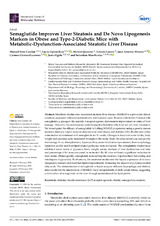Mostrar el registro sencillo del ítem
Semaglutide improves liver steatosis and de novo lipogenesis markers in obese and type-2-diabetic mice with metabolic-dysfunction-associated steatotic liver disease
| dc.contributor.author | Soto-Catalán, Manuel | |
| dc.contributor.author | Opazo-Ríos, Lucas | |
| dc.contributor.author | Quiceno, Hernán | |
| dc.contributor.author | Lázaro, Iolanda | |
| dc.contributor.author | Moreno, Juan Antonio | |
| dc.contributor.author | Gómez-Guerrero, Carmen | |
| dc.contributor.author | Egido, J. | |
| dc.contributor.author | Mas-Fontao, Sebastián | |
| dc.date.accessioned | 2024-03-04T09:36:52Z | |
| dc.date.available | 2024-03-04T09:36:52Z | |
| dc.date.issued | 2024 | |
| dc.identifier.issn | 1422-0067 | |
| dc.identifier.uri | http://hdl.handle.net/10396/27601 | |
| dc.description.abstract | Metabolic-dysfunction-associated steatotic liver disease (MASLD) is a prevalent clinical condition associated with elevated morbidity and mortality rates. Patients with MASLD treated with semaglutide, a glucagon-like peptide-1 receptor agonist, demonstrate improvement in terms of liver damage. However, the mechanisms underlaying this beneficial effect are not yet fully elucidated. We investigated the efficacy of semaglutide in halting MASLD progression using a genetic mouse model of diabesity. Leptin-receptor-deficient mice with obesity and diabetes (BKS db/db) were either untreated or administered with semaglutide for 11 weeks. Changes in food and water intake, body weight and glycemia were monitored throughout the study. Body fat composition was assessed by dual-energy X-ray absorptiometry. Upon sacrifice, serum biochemical parameters, liver morphology, lipidomic profile and liver-lipid-related pathways were evaluated. The semaglutide-treated mice exhibited lower levels of glycemia, body weight, serum markers of liver dysfunction and total and percentage of fat mass compared to untreated db/db mice without a significant reduction in food intake. Histologically, semaglutide reduced hepatic steatosis, hepatocellular ballooning and intrahepatic triglycerides. Furthermore, the treatment ameliorated the hepatic expression of de novo lipogenesis markers and modified lipid composition by increasing the amount of polyunsaturated fatty acids. The administration of semaglutide to leptin-receptor-deficient, hyperphagic and diabetic mice resulted in the amelioration of MASLD, likely independently of daily caloric intake, suggesting a direct effect of semaglutide on the liver through modulation of the lipid profile. | es_ES |
| dc.format.mimetype | application/pdf | es_ES |
| dc.language.iso | eng | es_ES |
| dc.publisher | MDPI | es_ES |
| dc.rights | https://creativecommons.org/licenses/by/4.0/ | es_ES |
| dc.source | Int. J. Mol. Sci., 25(5), 2961 (2024) | es_ES |
| dc.subject | Diabetes | es_ES |
| dc.subject | Insulin resistance | es_ES |
| dc.subject | GLP1 receptor agonists | es_ES |
| dc.subject | Obesity | es_ES |
| dc.subject | Semaglutide | es_ES |
| dc.subject | Steatosis | es_ES |
| dc.title | Semaglutide improves liver steatosis and de novo lipogenesis markers in obese and type-2-diabetic mice with metabolic-dysfunction-associated steatotic liver disease | es_ES |
| dc.type | info:eu-repo/semantics/article | es_ES |
| dc.relation.publisherversion | https://doi.org/10.3390/ijms25052961 | es_ES |
| dc.relation.projectID | Gobierno de España. Grants RTI2018-098788-B-I00 | es_ES |
| dc.relation.projectID | Gobierno de España. PID2021-127741OB-I00 | es_ES |
| dc.relation.projectID | Gobierno de España. DTS19/00093 | es_ES |
| dc.relation.projectID | Junta de Andalucía. 1381179-R | es_ES |
| dc.rights.accessRights | info:eu-repo/semantics/openAccess | es_ES |

